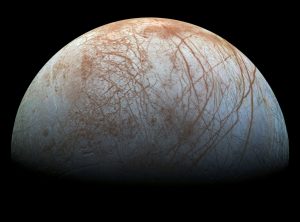Media
Transcript
Today we will be joined by PSI’s own Dr. Cathy Johnson, one of the researchers in a recent study of Mars’ Magnetic Field. Using Mars Maven data, they found indications that Mars had a magnetic field as recently as 3.7 billion years ago. Dr. Johnson’s work addresses a myriad of global datasets that allow her to probe the internal structure of other worlds while living here on Earth.
Before we get to the interview, however, let’s take a look at the news.
Today’s top story looks at an area of astronomy that rarely makes headlines: pulsating variable stars. As some of you may know, I started my research career looking first at TT Tauris in radio and then moved back to optical astronomy with Cepheids and RR Lyraes. In grad school, I switched to extra-galactic astronomy because I was told that pulsating variables were essentially a solved problem, and there just wouldn’t be funding or jobs doing the research I most enjoyed. Here’s the thing: stars have long been under-appreciated and labeled solved by folks that study things that look more complicated on the outside – folks who often fail to realize just how complex stars can be on the inside. As more and more researchers have to look at stars to find planets, the messiness of stars is starting to get more attention, and I am so here for it.
Variable stars come in lots of kinds. Some flare up randomly. Some darken suddenly. Pulsating variable stars are stars that have just the right in-balance of gravity, temperature, and energy generation that as light pushes outward it sometimes gets stolen by the stars’ outer atmosphere. Unable to escape, thanks to effects like ionization and changes in opacity, the photons increase in pressure until they can push the star into becoming a bigger star… this changes the temperature and the behavior of the outer star, making it possible for photons to fly free again. … which cools the star which subsequently collapses. We see this effect as stars visibly changing in brightness and color, and for many stars, these changes can be seen without a telescope or binoculars. All you need is your eye and clear darkish skies.

CREDIT: NASA’s Goddard Space Flight Center
One of the favorite targets of backyard astronomers is Delta Scuti stars. These young stars have chaotic looking brightness changes that reflect rapid rotation and pulsations we haven’t been able to understand….. At least until now.
Astronomers using the TESS and Kepler exoplanet observatories along with ground-based telescopes have found that there are two different classes of Delta Scuti stars that can be sorted. One set of stars behaves in insensible ways, with the entire surface of the star moving in concert. The other set is harder to imagine – different parts of the star actually pulsate out of phase with each other, with different quadrants alternatingly going in and out. This is ridiculously hard to sort when stars are rotating rapidly. The amount we see is a function of which quadrants are pulsed bright and which are facing us, and the facing us is changing.
But, one team, led by Tim Bedding, has just published a paper in the journal Nature that shows that ridiculously hard is not the same as impossible. They have sorted solutions, and just like the harmonics of a horn tell us the shape of the horn, and seismic waves through the earth tell us the structure of our planet, these asteroseismic waves tell us the shapes inside the stars.
These new findings are already allowing researchers to use these pulsating young objects to determine the age of their surroundings, including measuring the age of a stream of stars orbiting our Milky Way.
Pressures of all kinds affect the periodic effects we see in our sky. Stars pulsate, galaxies echo, and even small moons can erupt when their internal pressure gets too great. We know from clear images of the moon Enceladus, taken by the Cassini mission, that this tidally tortured moon erupts organic-rich geysers into space.

CREDIT: NASA/JPL-Caltech/SETI Institute
The question has been, do we have inarguable evidence to prove the same is happening at Jupiter’s moon Europa. There have been hints in Hubble images, and data from Galileo that can be interpreted as eruptions but… nothing definite. And we still don’t have anything I’d label definitive, but we do have one more computer model saying, yeah, there must be geysers. Looking at data from Galileo’s Energetic Particles Detector from the spacecraft during the same time period when other instruments detected behavior consistent with a geyser, a new team led by Hans Huybrighs found fewer photons then expected, and the only way they can explain this with their models is if they include a geyser. These teams are in many ways trying to say, “Yes there is a Geyser,” by looking at a shadow in the data. So far, nothing else fits the gap we’re seeing. When it someday makes its way toward Jupiter, the Europa Clipper will be able to provide a final answer on geysers or not. Until then, Juno doesn’t have the right setup, so we’re left with local detectors or data, and models to try and figure out what is going on. This work appears in Geophysical Research Letters.
The distances to these interesting worlds can be hugely frustrating, and the brief time that spacecraft spend getting us data is never long enough. At Jupiter, Galileo gave us years and gigabytes of information. At Pluto… New Horizons had moments. But sometimes moments are enough to get just the right info to start something awesome.

atmosphere, acquired by the New Horizons spacecraft on July 14, 2015.
CREDIT: NASA/JHUAPL/SwRI
New Horizons looked back at Pluto after its flyby and discovered the backlit planet haloed by illuminated haze. Sadly, that image set was New Horizon’s only chance to explore this phenomenon. Now, earthbound observers have taken to the sky with the SOFIA airborne observatory to study this haze with infrared and visible light detectors. While they can’t get stunning imagery, they can study Pluto in special moments when Pluto passes in front of a star, and its atmosphere gets backlit. This has added to New Horizons’ data and given us data over time. Predictions had been that Pluto’s atmosphere would collapse out as Pluto moved farther from the Sun, but the rate at which that is happening wasn’t matching pre-New Horizon models. With the new data and continued observations from SOFIA, they’ve proven that the particles in Pluto’s atmosphere are extremely small and able to stay lofted longer, allowing the haze to linger. This new work was led by Michael Person and appears in the journal Icarus.
Unfortunately, we can’t linger on Pluto. In just a moment…I’ll be joined by Dr. Catherine Johnson to talk Mars, Magnetic Fields, and pursuit of the understanding of the red planet’s evolution. This interview was recorded earlier today live on Twitch.tv/CosmoQuestX.
Learn More
NASA’s TESS Enables Breakthrough Study of Perplexing Stellar Pulsations
- NASA Goddard Space Flight Center article
- University of Hawai’i News article
- University of Central Lancashire article
- “Very Regular High-Frequency Pulsation Modes in Young Intermediate-Mass Stars,” Timothy R. Bedding et al., 2020 May 13, Nature
Jupiter’s moon Europa: New evidence of watery plumes
- Max Planck Institute for Solar System Research article
- “An Active Plume Eruption on Europa During Galileo Flyby E26 as Indicated by Energetic Proton Depletions,” H. L. F. Huybrighs et al., 2020 April 29, Geophysical Research Letters
SOFIA Finds Hidden Clues in Pluto’s Haze
- USRA press release
- NASA article
- “Haze in Pluto’s atmosphere: Results from SOFIA and ground-based observations of the 2015 June 29 Pluto occultation,” Michael J. Person et al., 2020, to appear in Icarus
Credits
Written and Hosted by Pamela Gay
Audio Editing by Ally Pelphrey
Content Editing by Beth Johnson
Video Editing by Tim Hawkins
Intro and Outro music by Kevin MacLeod, https://incompetech.com/music/


 We record most shows live, on Twitch. Follow us today to get alerts when we go live.
We record most shows live, on Twitch. Follow us today to get alerts when we go live.